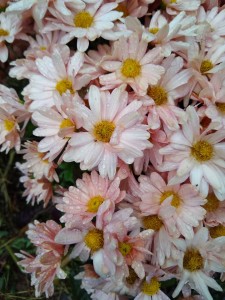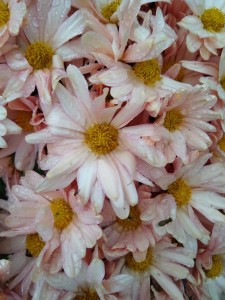 The tall asters in my garden are finishing their bloom extravaganza, which makes me a bit sad. It is the last big hurrah of the gardening season and it means that I will have to cut them all back, which is not a small endeavor. It also means that I won’t have another big, Cecil B. DeMille-type flower show until next spring.
The tall asters in my garden are finishing their bloom extravaganza, which makes me a bit sad. It is the last big hurrah of the gardening season and it means that I will have to cut them all back, which is not a small endeavor. It also means that I won’t have another big, Cecil B. DeMille-type flower show until next spring.
Fortunately there are consolations. The most notable is the imminent opening “Clara Curtis’, an old-fashioned chrysanthemum in the back garden. ‘Clara’ charms with long pink petals or “rays” surrounding a yellow center. It has lived in my garden for ten years, suffering with equanimity through all kinds of weather and very little maintenance. With the exception of a few rosebushes that continue producing until hard frost, ‘Clara’ is the last perennial to flower. Sometimes I have even inserted a few of the lovely pink daisies in the Thanksgiving centerpiece.
Botanically speaking ‘Clara Curtis’ is a chrysanthemum, but it is unlike the “hardy” chrysanthemums currently packing the pallets in garden centers and adorning doorsteps, window boxes and patios everywhere. Those mums are greenhouse-grown and their growth has been carefully timed for optimal display in late August through early October. The plants are trimmed and trained into the appealing cushion shape that has earned them the nickname “cushion mums”.
Mass market mums are beautiful and provide welcome color, but unless you get them in the ground many weeks before the first frost, most will not have time to establish roots before the ground freezes. The vast majority of people treat these hothouse beauties like annuals anyway, and after they flower, the plants end up on compost piles or at the curb for bulk pick-up.
The older, garden mums are sometimes called “Korean chrysanthemums”, even though they did not actually arrive here from Korea. Instead they were most likely descended from Chrysanthemum zawadskii, native to Korea, Japan, northern China and Manchuria. Botanist Graham Rice theorized that the zawadsii chrysanthemums may have been crossed with a Japanese dwarf species, Chrysanthemum yezoense. The result was the so-called “rubellum” group of mums, which cropped up in England around 1929 and arrived in the United States in 1936. My ‘Clara Curtis’ is a rubellum.
Once the rubellums came to America they fell into the hands of Alexander Munnings, a Connecticut breeder and nurseryman. Munnings promptly crossed them with other mum species. The result was the Korean chrysanthemums, which are distinguished by a daisy-like appearance and a growth habit that is looser and less formal than the common garden center varieties Masses of them bloom each fall around Halloween in the Conservatory Garden at New York’s Central Park.
Korean chrysanthemums are not easy to find at run-of-the-mill plant merchandisers and big-box stores. I discovered a couple of unnamed peach-colored ones that look very like ‘Single Apricot Korean’, in a really excellent nursery about 20 miles from my town. Online vendors carry better selections, and they are worth seeking out.
If you want something that is easy to grow, but still has the look of a modern florist’s mum, try ‘Emperor of China’, which can grow up to four-feet tall, but is easily kept to a smaller size. ‘Emperor’s dark rose buds open to fully double pink flowers. ‘Gay Mood’ is a similarly extravagant yellow-flowered variety. For something a little simpler, but even more striking, try ‘Cathy’s Rust’, with terra cotta-colored, semi-double petals surrounding large yellow centers.
Smaller gardens or containers might welcome, short growers like the white, button mum, ‘Baby Tears’, or the purple ‘Gilbert Becker’, both of which top out at only 16 inches.
Garden chrysanthemums prefer a sunny spot and absolutely must have well-drained soil to combat root rot. Established plants can get through dry spells, but do better with a bit of supplemental water during weeks with no rain. Promote branching and good flower production by cutting back the tips of young shoots around Memorial Day and the Fourth of July. The plants appreciate winter mulch, which should be removed in early spring. Happy garden mums will multiply via underground roots and can be easily divided every few years.
For best results, plant the old-fashioned garden chrysanthemums in spring, giving them plenty of time to establish themselves for fall bloom. Right now, you can check out the online offerings and order your choice of colors and styles for spring delivery. Good selections are available at Niche Gardens, 1111 Dawson Road, Chapel Hill, NC 27516; (919) 967-0078; www.nichegardens.com. Bluestone Perennials is another good source: 7211 Middle Ridge Rd. Madison, OH 44057, (800) 852-5243; www.bluestoneperennials.com.

